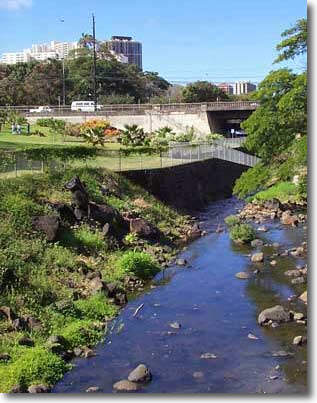Honolulu, Hawaii is criss-crossed with streams no one sees. They are auwai (‘auwai in Hawaiian), irrigation ditches dug by Native Hawaiians to divert water from Oahu’s many streams to lo’i, wetland taro patches.
Once upon a time, the entirety of Hawaii’s coastal plains was covered in terraced plots of taro, a staple of the Hawaiian diet and a sacred plant throughout Polynesian culture. Auwai crisscrossed the landscape. Water flowed from one patch to the next before returning, filtered, to the fish and salt ponds below.
Today, there is little evidence of this complex irrigation network, especially in Honolulu, where, like in other American cities, even natural streams have been buried, channelized or diverted into manmade canals. The auwai that Howard Hughes discovered was likely buried in the 1920s, encapsulated in concrete and forgotten.
Now, the Howard Hughes Corporation is exploring ways to daylight the stream, which originates roughly half a mile inland.
The vision is to make the restored waterway a central feature of a new public park. “We’re always looking for inspiration in history,” says Race Randle, the company’s senior director of development. “You couldn’t ask for better inspiration. The water is still flowing.”
Photo of visible Honolulu stream by hi.water.usgs.gov

